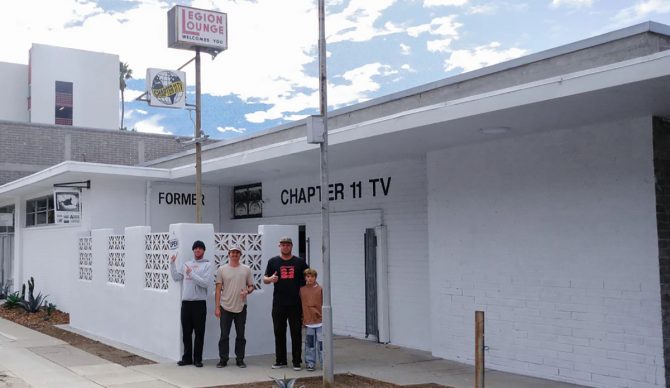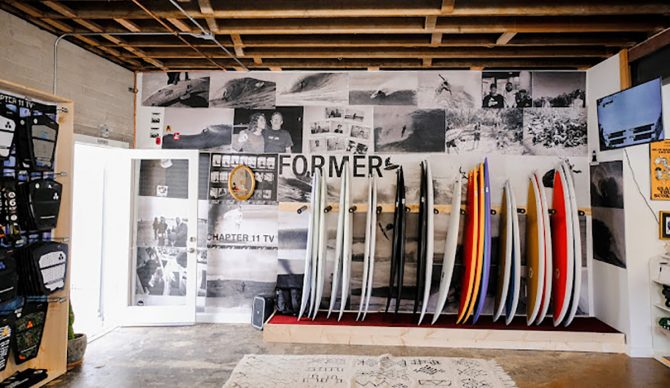
Pro-surfer owned shops? Makes sense. Photo: Chapter11
Sam George once pointed out in a piece titled “Shop Talk” that surf shops exist in malls in America. This, to George, signifies a serious problem, and he’s right. After all, Craig Stecyk said it best when he wrote that surf shops are meant to be “the sport’s information centers, supply depots, halfway houses, classrooms, libraries, churches, banks and museums.”
Surf shops should serve as places to hang out, places to exchange information, to buy and sell equipment. Surf shops should be places for surfers to be surfers, even if they aren’t directly buying something. Nowadays, it feels like these shops are few and far between. No one walks into a RVCA store or a Rip Curl store just to shoot the breeze with whoever is zipping up display wetsuits.
George theorized that this widespread popularity, and hence decline in authenticity, of surf shops has something to do with “surfing’s billion-dollar fashion boom,” and now, surfboards are for display only. George opined that surf shops should have groms around, sand on the floor, a “real pretty girl behind the counter,” and photos of local heroes hung up on the walls.
Jokes aside, I know what he means. I was never a shop rat like some of my friends who grew up in California. However, I have been the girl behind the counter (literally, not in the Sam George sense of the term) in a number of surf shops from Oahu to Maine.
Working in a cool surf shop doesn’t even feel like a real job. The good ones are family owned, small, and don’t make you clock in or out using a computer. They advertise their products on small social media accounts, have the kids working the shop model the clothes, and buy consignment boards off people in-store. They’re run by people who actually surf, and therefore are closed when big swells come in, and also whenever the owners feel like it. The owners usually drive cars that were made before 1985 and watch Surfline cams and stream Momentum Generation surf movies on a small TV in the corner of the store. Most of the time you run the store by yourself, and like Sam George says, there are groms around and people who come in barefoot and it’s a great time.
All of this to say, I can tell you that working in the Rip Curl outlet or most any shop in a mall looks about as fun as sitting in a cubicle Monday through Friday. Unfortunately, it seems like these stores have overtaken the mom and pops stores that used to be in surf towns across the country. This bums me – and apparently Sam George – out. But I have a strong indication that this is subject to change, and soon.
The first omen is that Dane Reynolds recently opened a new Chapter 11/Former store in Ventura, California (or technically, re-opened in a new location). That grand re-opening included a screening of the Chapter 11 film “Skinny Meat Head,” starring Eithan Osborne, live music from Raging Arb and the Redheads, and a knockout basketball tournament. If it sounds a little rootsy, that’s because, especially compared to other operating surf shops in California (like Rip Curl, RVCA, Billabong, or the list goes on) it is.
This event is hardly the only one of its kind. Last month, on December 8, Haleiwa saw the opening of the first standalone Florence Marine X store, right where John John Florence grew up. The opening was a hit, with surfers and fans of Florence pulling up from far and wide to celebrate under the iconic red flag. Before that, San Clemente’s “surf ghetto” saw the opening of a women-specific surf shop, All Swell Surf. San Clemente is also witnessing an Abysse store close to opening in town as well, which was promoted on social media by Anna Gudauskas (founder of Sage Brush Bags and the wife of pro surfer Dane Gudauskas).
While Chapter11’s style of store opening is the heart and soul of surfing and reflects that pro surfers recognize the value in making their money work for them (although that is, and has been, true for a while as well), it also displays something else. These store openings are an omen that a revolution is on the horizon, if it isn’t happening already. The surf industry is long overdue for a shift to new, smaller, surfer-owned and loved brands, and we are finally seeing that shift occur in real time.
Surf shops began as locations opened, operated, and used by surfers. They varied widely in appearance, affected by whoever was in charge of them. By the mid-60s, things had streamlined a bit, but surf shops were still surf shops. Surf shops were hangout zones. Even most of the names considered “big brands” today started out the way Dane Reynolds did a month ago: with storefronts owned and operated by people who really surfed.
This next bit is kinda listy, but bear with me: The first surf shop to ever open was Velzy Surfboards in 1949, when Dale Velzy opened his factory storefront in Manhattan Beach. In 1952, Jack O’Neill opens another of the very first shops in San Francisco. In 1961, Ron Jon Surf Shop opened in New Jersey (by a man who began selling surfboards out of his parents’ house). In 1969, Rip Curl was founded by surfers Doug Warbrick and Brian Singer in Torquay, Australia. In the ‘70s, Lightning Bolt opened in Honolulu, Hawaii. I could keep going, but my point is that the brands we look at and think, “sellout,” now used to be the up-and-coming brands of their time.
Velzy boards are now sold at other shops, not exclusively at a Velzy storefront (and the original one is no more). O’Neill is one of the biggest brands in surfing, but to my knowledge there is no surf shack a la the 1950s in San Francisco. Ron Jon? I could name five people who have never surfed who own brightly colored Ron Jon shirts. Rip Curl? It has outlet stores that feel more like Best Buys than surf shops. Lightning Bolt? The classic boards are cool, but there is a lot of random clothing and lifestyle apparel for sale as well.
This cycle is somewhat inevitable: brands or shaper names pop up from surfers who see a hole to fill in the industry, become uber successful, and ultimately lose the core audience that rocketed them to fame. O’Neill, for example, still makes great wetsuits, but is no longer a niche name. However, some of the big brands have strayed so far from surf culture it brings into question the value of big brands in surfing.

Just what the industry needs. Photo: Chapter11
RVCA, for example, recently chose model (and not surfer) Alexis Ren as the face of its 2024 women’s apparel campaign. Even more offensive were the clothes on offer: tennis outfits, leggings, and virtually everything else but wetsuits, advertised by photos of Alexis Ren and actual surfer Bettylou Sakura Johnson sitting on longboards, leashes on, in calm water. It is almost insulting, but then again, what surfer is shopping for clothes at RVCA anyway? This is just one in a long list of examples of how surf brands almost inevitably always lose their way.
It may come as no surprise that RVCA is now owned by Boardriders after being bought out from Billabong. Boardriders is the company that owns Roxy, Billabong, Quiksilver, and Vonzipper, among others. (And yes, all of those brands were, at one time, as core as Florence Marine X or Former seem today.) This begs the question: will Former, Florence Marine X, and Abysse suffer the same fate as Rip Curl and RVCA before them? Despite the fact that history tends to repeat itself, I don’t think so, and here’s why.
Quite simply, the surf industry is oversaturated. There’s no more room for another Hobie, or Bing, or Rip Curl, or O’Neill, or so on and so forth. Former will not become the next Rip Curl, not because Dane Reynolds is so far removed from Doug Warbrick, but because surfing already has a shop serving its clientele on every corner. The growth needed to match the trajectory of these brands that popped up between the ‘50s and ‘80s is just non existent today. There is, however, a need for niche surf brands and products: women-specific wetsuit brands, or high-end swim fins, or surf cafes that offer hangout spots where big brand stores no longer serve that function.
Former (Chapter11), Florence Marine X, and Abysse are all examples of surf brands that have expanded to storefronts and serve unique, core audiences within the surf community. I hope they’re all successful, because it is nice to see new brands run by surfers crop up in surf towns. I also secretly hope they don’t see the same numbers in terms of growth that RVCA, Rip Curl, or any of the other corporate-feeling surf brands saw, because I like them the way they are right now. Even if they do though, it’s okay, because the cycle is always in motion, and 10 years from now, new brands will crop up where these ones left off.

